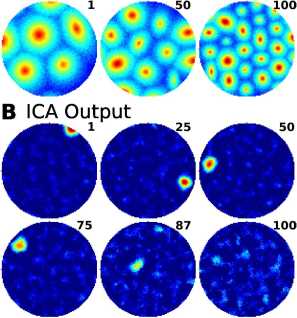A Grid Cell Input

C Random Rotation Output
D PCA Output
E SFA Output

Figure 1: A: Spatial firing pattern (SFP) of the input units representing grid-cells. Three
out of 100 units are shown. B: SFP of six out of 100 output units, computed by independent
component analysis as a means of Sparsification. Units are ordered by decreasing sparseness
(kurtosis). Place fields of sparser units tend to have higher peak activity and are more often
located at the border of the enclosure, whereas less sparse units tend to have multiple place
fields. C: SFP of three out of 100 typical output units computed by random mixtures of the
inputs. D: SFP of 1st, 50th, and IOOth output computed by principal component analysis. E:
SFP of 1st, 50th and IOOth output computed by Slow Feature Analysis. Activities are color
coded: red-high, green-medium, blue-zero activity. The full set of results can be viewed at
http: / /itb.biologie.hu-berlin.de / ~franzius/gridsToPlaces /
More intriguing information
1. Managing Human Resources in Higher Education: The Implications of a Diversifying Workforce2. Manufacturing Earnings and Cycles: New Evidence
3. On Social and Market Sanctions in Deterring non Compliance in Pollution Standards
4. The name is absent
5. Voluntary Teaming and Effort
6. Migration and Technological Change in Rural Households: Complements or Substitutes?
7. Volunteering and the Strategic Value of Ignorance
8. EMU: some unanswered questions
9. The storage and use of newborn babies’ blood spot cards: a public consultation
10. The name is absent